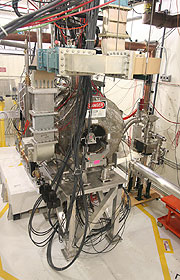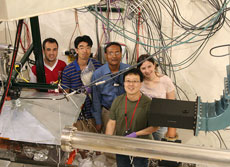Successful beam test brings a muon collider closer

The beam pipe leading into the solenoid magnet, with the HPRF cavity installed in the MTA experimental hall. Photo: Yagmur Torun, R&D

From left: Ben Freemire, Katsuya Yonehara, Mukti Jana, Moses Chung and Giulia Collura standing behind the HPRF cavity (under the hood) and beam pipe section. Photo: Yagmur Torun, R&D
A muon collider is closer to reality after a successful high-pressure hydrogen gas-filled RF (HPRF) cavity beam test at Fermilab. The test, conducted in the MuCool Test Area (MTA) at Fermilab by the MuCool collaboration, shows the beginnings of a practical solution to a difficult obstacle.
"This was years in the making," said MTA coordinator Yagmur Torun. "This idea of using HPRF cavities for muon cooling was first proposed in the early 2000s."
Muons, a heavier version of electrons, are elementary particles. They cannot break down into smaller components, like protons decaying into gluons and quarks. Muons have nearly 200 times the mass of electrons. Electrons would lose too much energy circling in an accelerator, while muons retain enough energy to reach collision speeds.
The problem is that the muons come into existence as a hot gas, which is much too large to fit through a conventional accelerator without beam cooling.
Muons also do not live long enough to complete the acceleration if standard beam cooling methods are used. With only 2.2 microseconds to accelerate and collide, every instance of muon action must be carefully controlled.
Ionization cooling is the only practical method that is fast enough for muons and the MuCool R&D program at Fermilab is aimed at developing components for muon cooling.
For muon cooling, RF cavities are used to accelerate particles within a strong magnetic field. The magnets help contain and focus the beam of particles. However, there were significant problems with the RF cavities, as scientists found that the cavities did not work well inside the magnets.
"The cavity would break down, or start arcing. It was unusable," said Torun, assistant professor at Illinois Institute of Technology with a joint appointment at Fermilab's Accelerator Physics Center (APC). "There were various ways to attack the problem, but then Rolland Johnson suggested we fill the cavities with gas."
Rolland Johnson, a physicist who worked at Fermilab for 30 years and founded Muons, Inc., introduced the novel concept of filling the RF cavities with hydrogen. The hydrogen gas would suppress the electrons stripped from the cavity surface, which had previously caused the breakdown of the cavity.
Physicists currently use RF cavities to bunch charged particles and move them forward through an accelerator. A standing wave, set at a particular frequency, pushes the beam particles forward to the next cavity.
"In 2005, we tested the hydrogen gas in the RF cavity," Katsuya Yonehara, Peoples Fellow at the APC and spokesperson for the HPRF beam test, said. "The results were promising. We saw the cavity would work in a magnetic field, but we had a remaining question-could a very intense muon beam cause the field in the cavity to collapse?"
In 2007, a beam line from the Fermilab Linac accelerator was installed in the MTA. It took four years of adjustments and upgrades before the beam line was ready for the test in July of this year.
"It worked," Torun said. "The cavity didn't break down. This is a big step in our search for a potential path for muon colliders and accelerators at Fermilab."
In the next few months, there will be a more detailed study.
"We're adjusting the cavity, and making improvements for studying its application to muon acceleration," Yonehara said. "We're seeing progress."
—Ashley WennersHerron
|